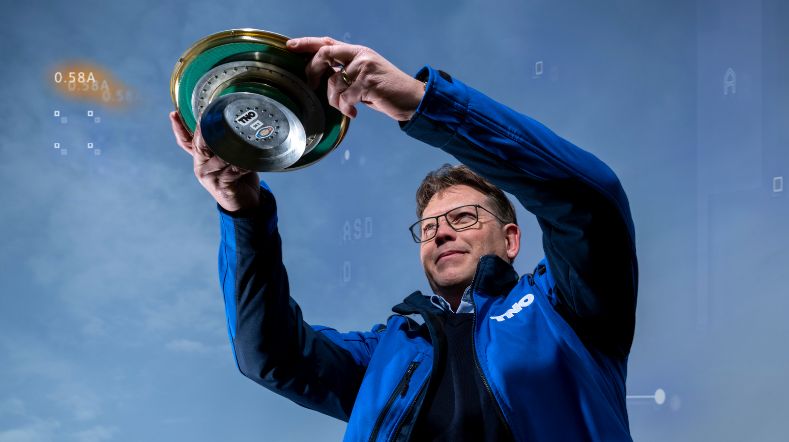
How do we limit damage to marine mammals from our underwater noise?
What do we humans know about sound underwater? Still relatively little, unfortunately. We do know that we produce a lot of underwater noise. It may even be so much that our noise pollution negatively affects life underwater. How can we prevent this and protect the fragile balance of the underwater world?
TNO is conducting research into the impact of one type of underwater noise. In collaboration with the Dutch Ministry of Defence and international partners, we are doing research in Norway on the effect of military sonar exercises on the behaviour of marine mammals. Frans-Peter Lam, senior researcher at TNO, is working on this research and explains how it is progressing.
‘Basically, sonar is a method in which sound waves are emitted and reflected by an object in the path of the wave’, says Lam. The location of the object is determined by measuring how long it takes for the sound wave to return’, he adds. ‘This sonar technique is called active sonar; we also call it “echolocation”. Sonar works both above and below water. If we compare human sight and hearing, above water we usually prefer to use sight. Underwater, however, our visibility is limited to a few metres at most. By listening using sonar, we can see a lot further.’
Five types of underwater noise
- Sonar: the sound source that is the subject of this article.
- Motorised shipping.
- Seismic surveys, in which 'airguns' are used to fire into the seabed to map gas and oil fields.
- Pile-driving work, for example for the construction of offshore wind farms.
- Explosions, usually to dispose of a mine, torpedo, or bomb found on the seabed, or sometimes for fishing using explosives.
In many cases of underwater noise, efforts are being made to reduce noise pollution in the natural world. When pile-driving, bubble screens – a kind of curtain of bubbles – can shield the surrounding area from the noise, and when a bomb is to be detonated, animals are quietly chased away from the area beforehand to protect them from the potentially lethal pressure wave from the blast.
Passive and active sonar
‘Knowing what goes on underwater became important for our safety at the time of World War II, when submarines were deployed’, Lam further explains. ‘Sonar with underwater microphones was used to detect enemy submarines. We call this passive sonar. However, this technique with hydrophones did not last when submarines became quieter and sailed closer to shore, where there was too much other noise. Active sonar, the 'echolocation method', was then deployed and continuously developed further. The armed forces still use various active sonar methods today, for
exercises but also, for example, to detect numerous World War II aerial bombs still lying in the North Sea.
Tests and exercises with sonar at sea have been carried out regularly by various countries since the late 1960s. Over time, mass strandings of marine mammals, especially beaked whales, were observed at several locations following exercises with active sonar. The link between the sonar exercises and the accidents involving this species of whale was not hard to make and logically attracted a lot of attention from conservationists.’
Beaked whales dive deep, on average 500 to 1,000, or even up to 4,000 metres for long periods, to catch squid and fish. Scientists suspect this is a strategy to avoid being attacked by orcas, which are their main predators. Most beaked whales seem to use their echolocation to find food only when deep enough and out of reach of orcas. Apart from that, they are silent during the dive. Through experiments with sonar and playing back sounds from orcas, scientists suspect that beaked whales interpret this as danger in both cases and flee or stay underwater longer. Staying underwater longer can lead to decompression symptoms and disorientation, resulting in possible stranding events.
Strandings on the Dutch coast
The southern North Sea is too shallow for beaked whales and submarines. So far, in the few beaked whales stranded on our shores that were fresh enough to be examined further, no evidence of sonar damage has been found. They are often emaciated animals, which have run out of food in the shallow North Sea and died from starvation or drowning.
Source: zoogdiervereninging.nl
Are sonar exercises always harmful to marine mammals?
‘Through the work of biologists, we know certain things about marine mammals’, says Lam. ‘Dolphins, orcas, and other cetacean species have similar hearing organs to humans and use sonar for communication, navigation, and locating prey and predators. Their hearing and the sound waves they emit are therefore crucial for their survival.
To detect a submarine, the Navy needs to transmit underwater sound waves over a relatively large area. The larger the area, the more likely that marine mammals will be present there. Navy sonar signals can confuse marine mammals, thus affecting their behaviour. As mentioned, there have been military exercises that clearly had a detrimental effect on marine mammals. But there have also been mass strandings in places where there were no military exercises in the wider area. So there are still many uncertainties in this field. By learning more about the effects of our sonar waves on the behaviour of marine mammals, we hope to better protect their lives.’
How is TNO helping the Ministry of Defence to protect marine mammals?
‘TNO supports the Dutch armed forces with research and innovations for security and sustainability’, says Lam. ‘Among other things, we are looking for an effective method to deploy sonar for the Navy, while at the same time protecting marine mammals as much as possible. For this study, we want to find out whether and how the behaviour of these animals changes when the Navy uses sonar in their environment.
The research has been in progress for several years and we now know more about the behaviour of different whale species. Humpback whales, for example, are not very interesting for our research because they are so calm that they hardly react to anything. We prefer working with orcas. We know where to find them, as they congregate around Norwegian herring fishers. When the fishers bring up the herrings with their nets, you can be sure there will be lots of orcas passing by to take advantage of an easily obtained meal.
When the orcas are feeding, they pay little attention to their surroundings and we can easily approach them. This will allow us to get close enough to place transmitters. We place one type of transmitter with suction cups and another by “shooting” the transmitter onto the orca's fin. There are no signs that the orcas are negatively affected by the transmitters.’
Another way to deploy sonar
Lam explains further: ‘At this stage of the study, we monitored the orcas' response using a new sonar method. Instead of emitting short and loud sounds underwater, we tested what the results were of softer but longer sound waves. A fairly groundbreaking feature here was that this time we received information on the boat in real time, instead of seeing something only after collecting the transmitters and reading the data. Working at sea is tough; you’re on a boat with many people for a long time, often facing bad weather and little daylight. But of course it’s fantastic to be able to work with these magnificent animals.’
Where are we now with this study?
‘To draw conclusions, we need to collect even more data and work with international partners’, Lam concludes. ‘More research is also needed on the effects of other marine noise sources. Fortunately, there’s an increasing focus on nature conservation worldwide. This makes it easier to find funding and develop innovations for this type of research. At the same time, there’s still a lot of knowledge to acquire. We’re happy to do our bit.’
Get inspired
Time setter story: Project manager Christian Trampuz


Pioneering on the edge of physics: quantum chips tested faster and faster


How TNO’s Ines Corveira Rodrigues shapes tomorrow's quantum world


Unveiling the future of vapour detection technology


EMBRAPII and TNO signed a Memorandum of Understanding (MoU)




